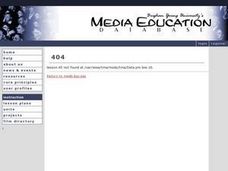Curated OER
What Did You Say Relay
First graders each write a sentence describing how they want the other students to race. The teacher calls one of students to read his or her instructions. The other students compete as relay teams to complete the instructions.
Curated OER
Whose Land Is It Anyway?
Seventh graders comprehend the interaction and conflict beween Native Americans and white settlers in the years following the Civil War. They listen to T"his Land is Your Land." Students are asked what their interpretation of the...
Curated OER
A World without Color and a World with Color
Visual arts instructional activity involving the creation of a black and white picture followed by a re-creation of the same picture using color with an emphasis on contrast, depth, and mood.
Curated OER
Heroism in Hispanic Countries
Students investigate foreign newspapers written in Spanish. They pick an article to be read and summarized in English. This lesson develops the skill of word recognition and sentence structure.
Curated OER
Verb Patterns Pellmanism Game- Intermediate Version
Students sort verb tenses. In this English grammar lesson, students work with a partner to sort cards with verbs written on them into 3 piles including verbs with "ing," the infinitive form (meaning "want to"), and the infinitive form...
Curated OER
30 Day Journal
Young scholars collect articles, political cartoons, photographs and other artifacts relating to a specific traumatic event, such as September 11th. They reflect on their artifacts in written journals.
Curated OER
Communication on the Frontier: Postcards from the Edge
Eleventh graders explore the innovative ways pioneers used to leave messages along the trail to communicate to family and friends who were to follow.
Curated OER
Open Wide at the Dentist, "Aaaahh"
Study the /o/ in both written and spoken words by reciting a tongue twister and making words using Elkonin letterboxes. Next, write a message about frogs using /o/ words. Finally, listen to a short book talk on "Doc in the Fog" before...
Curated OER
Shelly's Ship is Coming to Shore!
Learners identify the digraph /sh/ in written and spoken language. After a brief discussion the independent and combined sounds of the phonemes /s/ and /h/ students practice identifying initial and final placement of the new digraph /sh/...
Curated OER
Collocation Patterns in English
In this preposition worksheet, students cross out incorrect prepositions in sentences and write the correct preposition above. Page includes teacher instructions for related activities and student reference pages.
Curated OER
Computers in the Classroom
Tenth graders identify and interpret modern poetry through exploration with guided instruction. Students use the Encarta Encylcopedia site to explore further modern poetry and locate poetry that inspires them. Students identify themes...
Curated OER
Show and Teach
Second graders write "how to" sequences for tasks so that another person can follow the sequence to perform the action. They write a "show and teach" once a month for evaluation.
Curated OER
Field Trip Summary Report
Students create a brief report summarizing their experience on a field trip or community based instruction trip. After returning from their experience, they jot down several points of interest. Students draw a picture that focuses on...
Curated OER
Sorting words (four-block)
Third graders each receive an index card with a word written on it. They look for spelling patterns such as "oi." Students sort the cards according to spelling pattern, and practice spelling words with the snap, clap, slap hand motions.
Curated OER
The Magic of Algebra: Original Lesson Plan
Students participate in a teacher led math "trick." The teacher "reads the mind of the students. The answer to the problem is always 4, and by following the directions, the teacher can guess that students are thinking of Denmark, and...
Curated OER
Food Pyramid
Second graders study nutrition and the food guide pyramid. They follow established procedures for use of programs :print in color only when directed, print only the number of copies directed by the teacher, select and use the programs...
Curated OER
Lots of Labels
Students examine labels in the classroom to connect the written word with a message. They discover photographs of local buildings and their purpose. They also practice the classroom rules based on the labels.
Curated OER
Lawson Fusao Inada
Students read and analyze poetry written by Lawson Fusao Inada. They read and discuss the executive order issued to Japanese Americans during WWII, take a field trip to the Nikkei Legacy Center, and read and discuss poems.
Curated OER
Phenomenology Lesson Plan #5: Character Part 2
Students examine the meaning of the word icon as it relates to media and pop culture. They watch and discuss film clips, write a mini-biography, take a Film Icon Quote quiz, and write a written response to the film clips.
Curated OER
Recognizing Text Relay
Fifth graders recognize and distinguish between different types of text. After a discussion of the various types of text, small groups compete in a relay race game demonstrating their knowledge of the text. Correct choices earn...
Curated OER
Sum it Up!!
Students work to develop comprehension strategies. Through modeling they discover how to summarize a written passage by deleting unnecessary information and using clustering or concept mapping for the most important items or events. In...
Curated OER
Addition Review
Students explore the concept of addition as used in the subject of Algebra while reviewing the different methods using a number line. The lesson includes examples for students to use for scaffolding for group work or whole class...
Curated OER
Food Poisoning
Students study the bacteria that cause food poisoning using a written resource. They complete a research worksheet entitled, "America's Most Wanted." Next, they create a short skit about the causes, symptoms, prevention, and other...
Curated OER
THOAN -Think Of A Number
In this puzzle worksheet, learners think of a number and follow twelve computations to do with that number. The answer to the puzzle is always one. Students make their own set of steps.

























